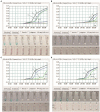Loop-mediated isothermal amplification combined with lateral flow biosensor for rapid and sensitive detection of monkeypox virus
- PMID: 37033067
- PMCID: PMC10080115
- DOI: 10.3389/fpubh.2023.1132896
Loop-mediated isothermal amplification combined with lateral flow biosensor for rapid and sensitive detection of monkeypox virus
Abstract
The ongoing outbreak of the monkeypox, caused by monkeypox virus (MPXV), has been a public health emergency of international concern, indicating an urgent need for rapid and sensitive MPXV detection. Here, we designed a diagnostic test based on loop-mediated isothermal amplification (LAMP) and nanoparticle-based lateral flow biosensor(LFB)for diagnosis of MPXV infection, termed MPX-LAMP-LFB. A set of six LAMP primers was designed based the ATI gene of MPXV, and LAMP amplification of MPXV templates was performed at 63°C for only 40 min. The results were rapidly and visually decided using the LFB test within 2 min. The MPX-LAMP-LFB assay can specifically detect MPXV strains without cross-reaction with non-MPXV pathogens. The sensitivity of the MPX-LAMP-LFB assay is as low as 5 copies/μl of plasmid template and 12.5 copies/μl of pseudovirus in human blood samples. The whole process of the MPX-LAMP-LFB assay could be completed ~1 h, including rapid template preparation (15 min), LAMP reaction (40 min)and result reporting (<2 min). Collectively, MPX-LAMP-LFB assay developed here is a useful tool for rapid and reliable diagnosis of MPXV infection.
Keywords: diagnosis; lateral flow biosensor; loop-mediated isothermal amplification; monkeypox virus; nanoparticles.
Copyright © 2023 Huang, Xiao, Jia, Sun, Fu, Xu, Cui, Huang, Qu, Zhou and Wang.
Conflict of interest statement
The authors declare that the research was conducted in the absence of any commercial or financial relationships that could be construed as a potential conflict of interest.
Figures





Similar articles
-
Loop-mediated isothermal amplification coupled with nanoparticle-based lateral flow biosensor for monkeypox virus detection.Talanta. 2024 Mar 1;269:125502. doi: 10.1016/j.talanta.2023.125502. Epub 2023 Dec 1. Talanta. 2024. PMID: 38070288
-
Rapid detection of monkeypox virus by multiple cross displacement amplification combined with nanoparticle-based biosensor platform.J Med Virol. 2023 Feb;95(2):e28479. doi: 10.1002/jmv.28479. J Med Virol. 2023. PMID: 36609918
-
Ultrasensitive and Specific Identification of Monkeypox Virus Congo Basin and West African Strains Using a CRISPR/Cas12b-Based Platform.Microbiol Spectr. 2023 Feb 22;11(2):e0403522. doi: 10.1128/spectrum.04035-22. Online ahead of print. Microbiol Spectr. 2023. PMID: 36821485 Free PMC article.
-
Loop-Mediated Isothermal Amplification Coupled With Nanoparticle-Based Lateral Biosensor for Rapid, Sensitive, and Specific Detection of Bordetella pertussis.Front Bioeng Biotechnol. 2022 Feb 8;9:797957. doi: 10.3389/fbioe.2021.797957. eCollection 2021. Front Bioeng Biotechnol. 2022. PMID: 35211469 Free PMC article. Review.
-
Lateral flow biosensor combined with loop-mediated isothermal amplification for simple, rapid, sensitive, and reliable detection of Brucella spp.Infect Drug Resist. 2019 Jul 30;12:2343-2353. doi: 10.2147/IDR.S211644. eCollection 2019. Infect Drug Resist. 2019. PMID: 31440069 Free PMC article. Review.
Cited by
-
Mpox disease, diagnosis, and point of care platforms.Bioeng Transl Med. 2025 Jan 2;10(3):e10733. doi: 10.1002/btm2.10733. eCollection 2025 May. Bioeng Transl Med. 2025. PMID: 40385539 Free PMC article. Review.
-
CRISPR-based strategies for sample-to-answer monkeypox detection: current status and emerging opportunities.Nanotechnology. 2024 Nov 4;36(4):042001. doi: 10.1088/1361-6528/ad892b. Nanotechnology. 2024. PMID: 39433062 Free PMC article. Review.
-
Rapid and reliable diagnosis of Moraxella catarrhalis infection using loop-mediated isothermal amplification-based testing.Front Bioeng Biotechnol. 2024 Jan 8;11:1330047. doi: 10.3389/fbioe.2023.1330047. eCollection 2023. Front Bioeng Biotechnol. 2024. PMID: 38260738 Free PMC article.
-
Rapid visual detection of Monkeypox virus by one-step LAMP-CRISPR/Cas12b assay.Virol J. 2025 May 20;22(1):151. doi: 10.1186/s12985-025-02780-0. Virol J. 2025. PMID: 40394594 Free PMC article.
-
Advances and challenges of mpox detection technology.Biosaf Health. 2024 Sep 11;6(5):260-269. doi: 10.1016/j.bsheal.2024.09.005. eCollection 2024 Oct. Biosaf Health. 2024. PMID: 40078738 Free PMC article. Review.
References
-
- von Magnus P, Andersen E, Petersen K, Birch-Andersen A. A pox-like disease in cynomolgus monkeys. Acta Pathol. (1959) 46:156–76. doi: 10.1111/j.1699-0463.1959.tb00328.x - DOI
-
- Meyer H, Perrichot M, Stemmler M, Emmerich P, Schmitz H, Varaine F, et al. . Outbreaks of disease suspected of being due to human monkeypox virus infection in the Democratic Republic of Congo in 2001. J Clin Microbiol. (2002) 40:2919–21. doi: 10.1128/JCM.40.8.2919-2921.2002, PMID: - DOI - PMC - PubMed
-
- WHO . WHO Monkeypox declared a Global Health emergency by the World Health Organization World Health Organization; (2022) [Accessed July 23, 2022].
Publication types
MeSH terms
Supplementary concepts
LinkOut - more resources
Full Text Sources

